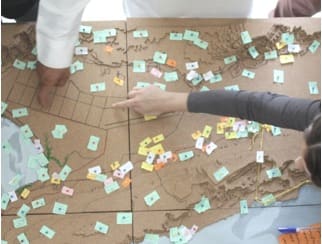
Reflect
Resources for further understanding and identifying territories of life
Publications:
- Bio-cultural diversity conserved by indigenous peoples and local communities – This compendium provides the a wide range of examples and analysis about how custodian indigenous peoples and local communities conserve biodiversity in territories of life.
- Recognising and supporting ICCAs—global overview and national case studies
- ICCAs and Aichi Targets
Resources and tools to plan and support inclusive grassroots discussions throughout an SSP
Methods: The main method for the SSP is grassroots discussions, which may be organized in a wide variety of contextually appropriate ways (see SSP Guide). As part of this, local teams may consider using any number of participatory methods to facilitate and support meaningful inclusion in those discussions. Some possibilities include the following (Prioritize any customary or locally familiar methods):
Community and public meetings
Beyond Fences Vol. 2 describes the purpose, key steps, and strengths and drawbacks of community and public meetings , noting that they “involve relatively large groups of people coming together to focus on a specific problem or purpose. A skilled facilitator can enhance the value of the meeting by managing the process and encouraging communication among all the participants. If required, more in-depth discussions can be provided for by breaking the meeting into small groups at various stages. Meetings may be held for a wide variety of purposes: e.g. to give and gather information; to discuss issues of relevance to the community; to achieve community agreement on an issue; to help identify problems and solutions; or to plan specific actions in response to evaluation results and recommendations. The results of focus-group interviews and individual interviews can be presented at public meetings; in this way the views of those who are unable or reluctant to speak in a larger public meeting can be given a wider voice (source anonymity being respected as necessary).” (Read more at Borrini-Feyerabend with Buchan 1997:122-123)
Key informant interviews, focus groups or other semi-structured discussions with small groups
For example, Beyond Fences Vol. 2 describes the purpose, key steps, and strengths and drawbacks of focus group interviews, noting that they “are semi-structured discussions with a group of people who share a common feature (e.g. women of reproductive age, shareholders in an irrigation system, users of a particular service, etc.) Participants are chosen by means of sampling procedures (e.g. from a cross-section of ages, a variety of land-area ownership, different resource-users, etc.). Depending on local conditions, a focus group can include as few as five and as many as 15 or more individuals. A list of open-ended questions is used to focus the discussion on the issues of concern but, as for natural group interviews, follow-up questions can be developed during the conversation. Focus group interviews were developed in market-research to determine customer’s preferences and expectations. Since the 1980s they have been used increasingly for sociological studies and in participatory research, particularly research to identify and describe group perceptions, attitudes and needs.” (Read more at Borrini-Feyerabend with Buchan 1997:132-134)
Natural group interviews or casual discussions with people where they gather in their everyday lives
Beyond Fences Vol. 2 describes the purpose, key steps, and strengths and drawbacks of natural group interviews , noting that they “are casual conversations with groups of people met in their natural settings, for example farmers working in their fields, mothers fetching children from school, people queuing for the bus, vendors and customers at the market, patients waiting in a health clinic, and so on. Conducting the interviews is a basic participatory research technique and is especially useful as part of a “participant observation” approach, where the researcher spends time in the community, making direct observations and discussing and checking them with community members. Natural group interviews are a means to get some broad sense of the local views on some issues. For instance, they may help to discover problems and expectations related to the conservation initiative. They can also identify the common interests leading individuals to cluster in small groups.” (Read more at Borrini-Feyerabend with Buchan 1997:131)
Observational and transect walks and transect diagrams
Beyond Fences Vol. 2 describes the purpose, key steps, and strengths and drawbacks of natural group interviews , noting that they “are observational walks across an area or through a village. The walks help identify important aspects of the local environment (biological, physical and social) which may be discussed on the spot. They can also be used to verify, through direct observation and discussions with people met along the way, the information gathered by other means. At the end of the walk the information collected can be summarized in a transect diagram which includes the key environmental features identified, an indication of relevant problems and resources, etc. There are two broad categories of transects: social and land-use. The former can provide information on housing density and types, infrastructures and amenities, cultural and economic activities, etc. The latter focuses on environmental and agricultural features such as cultivated land, forests, hill areas, types of soil and crops, and evidence of environmental degradation. The two can also be combined.” (Read more at Borrini-Feyerabend with Buchan 1997:136)
Publications:
- A toolkit to support conservation by indigenous peoples and local communities
- Implementing improved natural resource governance in practice – An action learning handbook for sub-Saharan Africa
- 80 tools for participatory development
- Beyond Fences: Seeking Social Sustainability in Conservation. Vol. 1 and Vol. 2
- Participatory Methods Toolkit: A practitioner’s manual. United Nations University
- Participatory Learning Action (PLA) Series
- Participatory dialogue: towards a stable, safe and just society for all